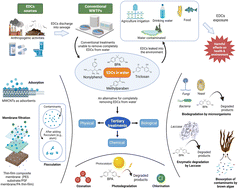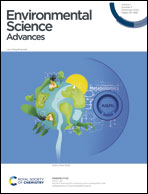Environmental persistence, detection, and mitigation of endocrine disrupting contaminants in wastewater treatment plants – a review with a focus on tertiary treatment technologies
Abstract
Endocrine disrupting chemicals are a group of contaminants that have severe effects on humans and animals when exposed, like cancer and alterations to the nervous and reproductive systems. The increasing concentrations of several endocrine disrupting chemicals in the environment are strongly related to anthropogenic activities, and as the population grows this problem becomes more relevant. Thus, wastewater is one of the main sources of endocrine disrupting chemicals, and the technologies employed during primary and secondary treatment in wastewater treatment plants cannot remove these contaminants. Due to this, researchers have tried to develop more efficient technologies for tertiary treatment of wastewater and reduce the concentration of endocrine disrupting chemicals discharged into the environment. Some of the most promising technologies include adsorption, ultrafiltration, advanced oxidation processes and biodegradation. The use of nanomaterials as adsorbents, catalysts, membranes and supports has played a key role in enhancing the efficiency of these technologies. The results showed that these technologies have great potential on the lab-scale, and even some of them have already been employed at some wastewater treatment plants. However, there are still some challenges to achieving a global implementation of these technologies, related to reducing the costs of materials and enhancing their current performance. The use of biomass/waste derived carbon materials and implementing hybrid technologies are accessible approaches for their implementation in tertiary treatment.

- This article is part of the themed collections: Environmental Science Advances Recent Review Articles, Topic Collection: Wastewater Treatment, Topic Collection: Sensors, Detection and Monitoring and Environmental Science: Advances – Editorial and Advisory Board Member Publications


 Please wait while we load your content...
Please wait while we load your content...